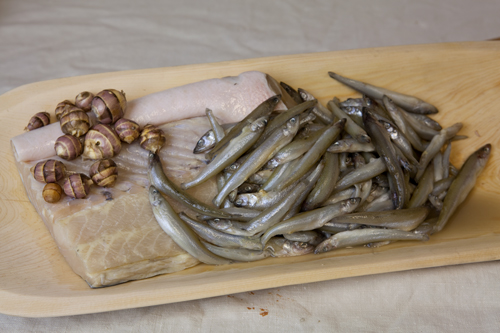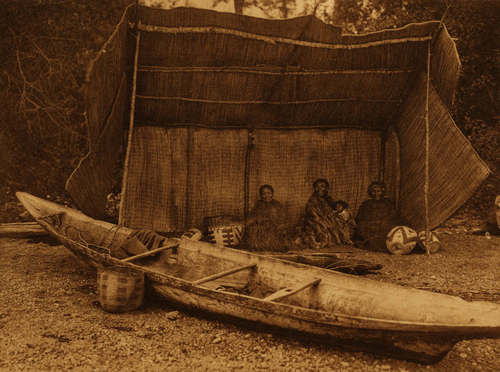As they paddle along the south shore of the Columbia River, the expedition sees Downstreamer Chinooks trolling for sturgeon. They have difficulty finding a dry place to camp among the swampy shores, but after fifteen miles they find a popular camping spot at the present Clatskanie River.
Wapato Bulbs, Sturgeon Filet, and Eulachon
© 2012 by Kristopher K. Townsend. Permission to use granted under the Creative Commons Attribution-Share Alike 4.0 International license.
Setting Out
at 7 A. M. we set out and continued our rout along the South Coast of the river against the wind and a strong current, our progress was of course but slow. at noon we halted and dined. here some Clatsops came to us in a canoe loaded with dryed anchovies [eulachon], which they call Olthen’, Wappetoe [wapato] and Sturgeon. they informed us that they had been up on a trading voyage to the Skillutes [Skilloots].—
—Meriwether Lewis
Skokomish Camp on Puget Sound
Edward S. Curtis (1868–1952)
© 2001 Northwestern University Library, Edward S. Curtis’s ‘The North American Indian’: the Photographic Images.
Downstreamer Chinooks
Soon after we had landed two Indians Came from a War kia cum [Wahkiakum] village on the opposite Side with 2 dogs and a fiew Wappato to Sell neither of which we bought.
—William Clark
Trolling for Sturgeon
after dinner we passed the river to a large Island 2 and continued our rout allong the side of the same about a mile when we arrived at a Cathlahmah [Kathlamet] fishing cam of one lodge; here we found 3 men 2 women and a couple of boys, who from appearances had remained here some time for the purpose of taking sturgeon, which they do by trolling.
they had ten or douzen very fine sturgeon which had not been long taken.
—Meriwether Lewis
Columbia River Bottomlands
the bottom lands are covered with cottonwood, the growth with a broad leaf which resembles ash except the leaf. the underbrush red willow, broad leafed willow, sevenbark, goosburry, green bryer & the larged leafed thorn; the latter is now in bloom; the natives inform us that it bears a freut about an inch in diameter which is good to eat.—
—Meriwether Lewis
Popular Camping Place
it was with some difficulty that we could find a spot proper for an encampment, the shore being a swamp for several miles back . . . . we found the entrance of a small creek which afforded us a safe harbour from the wind and encamped.
here we found another party of Cathlahmahs about 10 in number who had established a temperary residence for the purpose of fishing and taking seal. they had taken a fine parcel of sturgeon and some seal. they gave us some of the fleese of the seal which I found a great improvement to the poor Elk. here we found Drewyer and the Feildses who had been seperated from us since morning;
—Meriwether Lewis
Weather Diary
Aspect of the weather at Rise
Wind at rise
Aspect of weather at 4 O’Ck P. M. Wind at 4 OCk. P. M. cloudy after fair S. E. rain after clouds & rain S. E. cold this morning, but no ice nor frost. the Elder, Gooseberry, & honeysuckle are now putting fourth their leaves. the nettle and a variety of other plants are now springing up. the flower of the broad leafed thorn is nearly blown. several small plants in blume.
—Meriwether Lewis[2]To assist the reader, the editor of this web page has omitted the “Day of the Month” column and spelled out some abbreviations.


